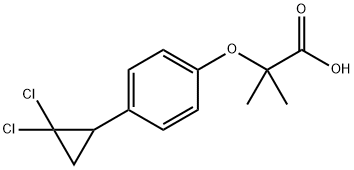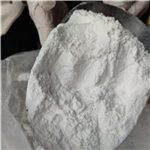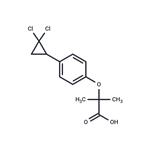Description
Ciprofibrate is a potent, long-acting hypolipidemic agent related to clofibrate,
bezafibrate and fenofibrate. It is effective in types IIa, IIb, IIX and IV
hyperlipoproteinemias, and produces a beneficial elevation of the anti-atherogenic
HDL.
Description
Ciprofibrate is an agonist of peroxisome proliferator-activated receptor α (PPARα; EC
50 = 0.9 μM in a transactivation assay). It is selective for PPARα over PPARγ and PPARδ at 300 μM. Ciprofibrate (250 μM) induces cell cycle arrest at the G
2/M and S phases in Fao rat, but not HepG2 human, hepatocellular carcinoma cells. It decreases fasting plasma levels of triglycerides and increases fasting plasma glucose levels in the apolipoprotein CIII transgenic mouse model of hypertriglyceridemia when administered at a dose of 10 mg/kg. Formulations containing ciprofibrate have been used in the treatment of hypertriglyceridemia.
Chemical Properties
Off-White to Pale Beige Solid
Originator
Sterling-Wintbrop (USA)
Uses
Peroxisome proliferator-activated receptor α (PPARα) is a ligand-activated transcription factor involved in the regulation of lipid homeostasis. Activation of PPARα results in expression of a variety of genes, particularly those involved in fatty acid β-oxidation, binding, and transport. Ciprofibrate activates PPARα with an EC50 value of 20 μM and only marginally affects PPARγ (EC50 = >300 μM). It has been shown to lower adipose tissue weight and reduce plasma insulin concentrations in obese rats and has been used clinically in the treatment of dyslipidemia. Ciprofibrate reportedly stimulates cholesteryl ester transfer protein expression and improves the flow of cholesterol through the indirect reverse cholesterol transport system, preserving plasma HDL.
Uses
Ciprofibrate is a hypolipemic agent, related structurally to Clofibrate (C586910). Ciprofibrate is used as an antilipemic.
Definition
ChEBI: Ciprofibrate is a monocarboxylic acid, a member of cyclopropanes and an organochlorine compound. It has a role as an antilipemic drug.
Manufacturing Process
A mixture of 8 g (0.0356 mol) of p-(2,2-dichlorocyclopropyl)phenol, 11.2 g
(0.28 mol) of sodium hydroxide pellets, 11 g of chloroform and 350 ml of
acetone was prepared at 0°C. The cooling bath was removed, the mixture
stirred for a minute and then heated on a steam bath to reflux temperature.
The reaction mixture was stirred at reflux for three hours and then
concentrated in vacuo. The residual gum was partitioned between dilutehydrochloric acid and ether, and the ether layer was separated, dried and
concentrated in vacuo. The residual oil (14 g) was partitioned between dilute
aqueous sodium bicarbonate and ether. The sodium bicarbonate solution was
acidified with concentrated hydrochloric acid and extracted with ether. The
ether solution was dried over anhydrous sodium sulfate and concentrated. The
residue (9.5 g of yellow oil) was crystallized twice from hexane to give 6.0 g
of 2-[p-(2,2-dichlorocyclopropyl)phenoxy]-2-methyl propionic acid in the form
of a pale cream-colored solid, MP 114°C to 116°C.
Therapeutic Function
Antihyperlipidemic
World Health Organization (WHO)
The safety profile of ciprofibrate is similar to that of clofibrate.
See also under clofibrate in full edition.
Biochem/physiol Actions
Peroxisome proliferator-activated receptor α (PPARα) agonist
Clinical Use
Hyperlipidaemia
Drug interactions
Potentially hazardous interactions with other drugs
Antibacterials: increased risk of myopathy with
daptomycin - try to avoid concomitant use.
Anticoagulants: enhances effect of coumarins and
phenindione. Dose of anticoagulant should be
reduced by up to 50% and readjusted by monitoring
INR.
Antidiabetics: may improve glucose tolerance
and have an additive effect with insulin or
sulphonylureas.
Colchicine: possible increased risk of myopathy.
Lipid-regulating drugs: increased risk of myopathy
in combination with statins and ezetimibe (Do
not exceed 10 mg of simvastatin and 20 mg of
rosuvastatin.1
) - avoid with ezetimibe.
Metabolism
Approximately 30-75% of a single dose administered to
volunteers was excreted in the urine in 72 hours, either
as unchanged ciprofibrate (20-25% of the total excreted)
or as a glucuronide conjugate. Subjects with moderate
renal impairment excreted on average 7% of a single
dose as unchanged ciprofibrate over 96 hours, compared
with 6.9% in normal subjects. In subjects with severe
insufficiency this was reduced to 4.7%.





